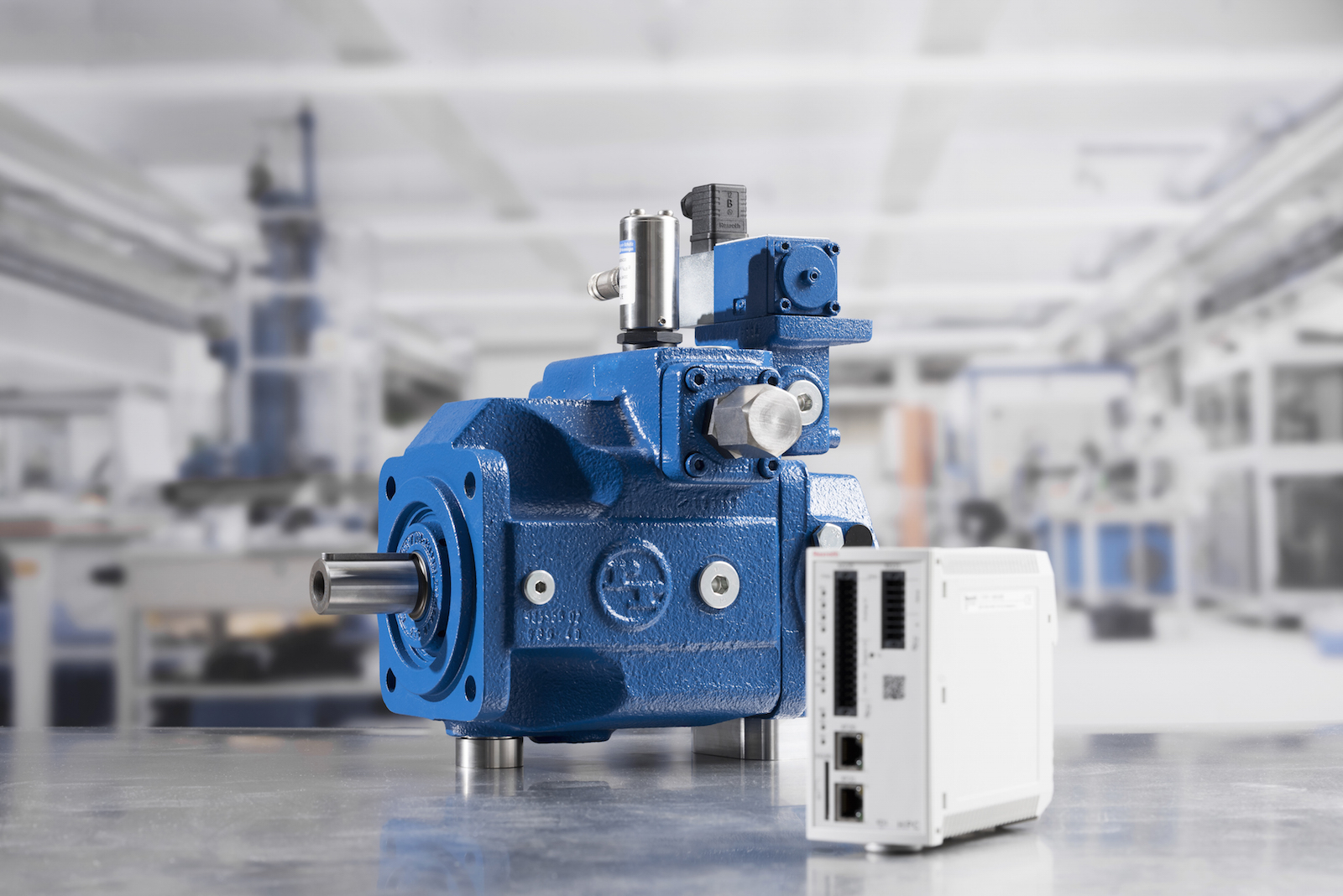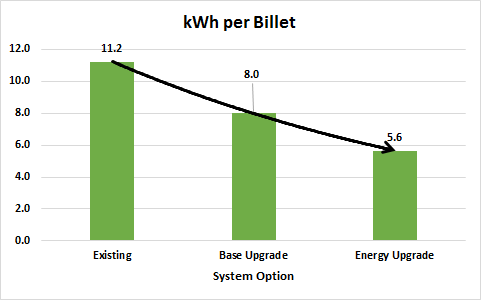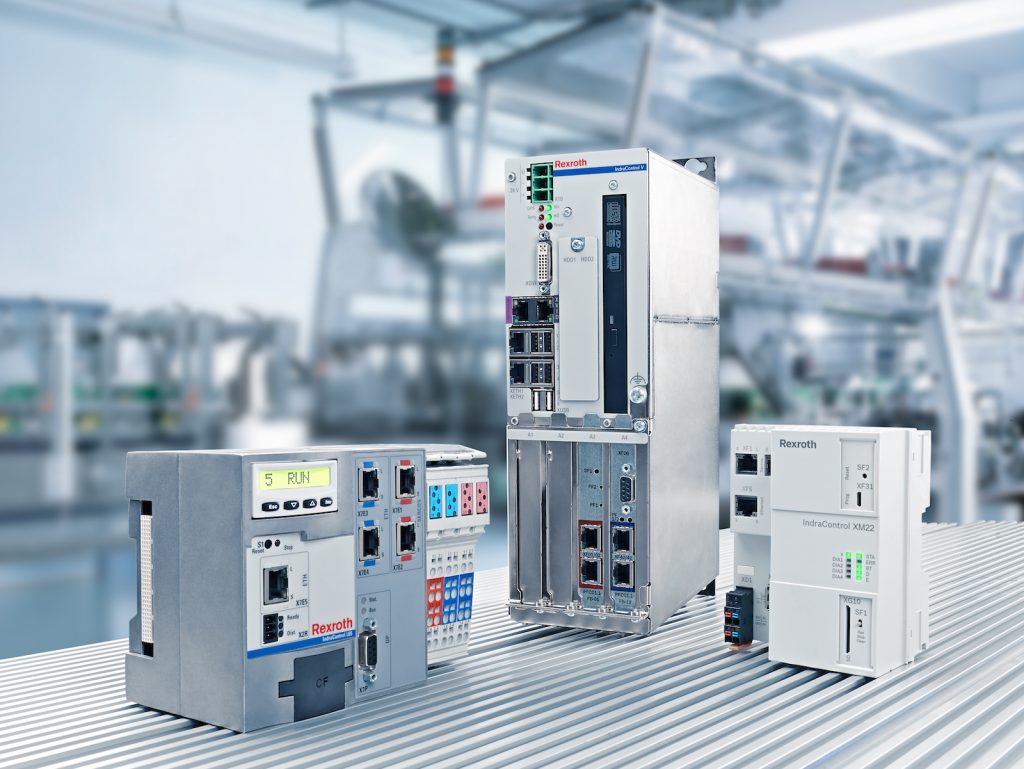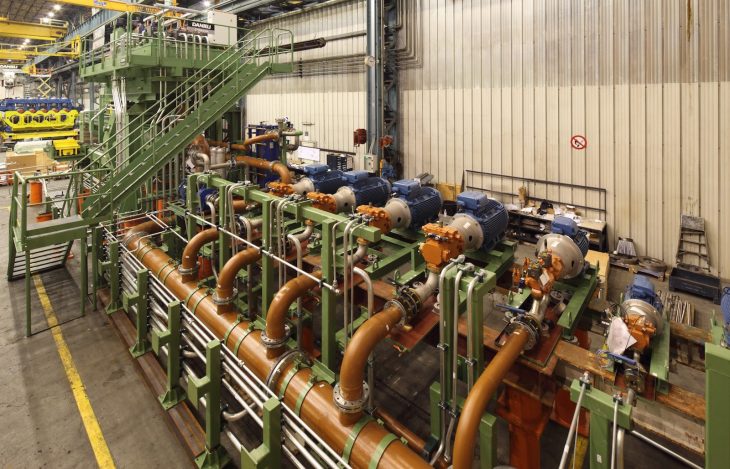By Tom LaCombe, Bosch Rexroth Corporation.
Editor’s Note: This article first appeared in the April 2017 issue of Light Metal Age. To read more articles from this issue, please subscribe.
A significant portion of extrusion press and system capacity in the Americas and Europe is comprised of press and auxiliary equipment that has been installed and operating for many years. This equipment, which has likely long ago paid for itself, is typically very robust and, therefore, can be expected to continue to perform well mechanically for many years to come, if reasonably maintained.
Hydraulic drive and control and human machine interface (HMI) product and system technologies have continued to evolve. Energy efficient drives and the latest in safety system concepts are becoming the standard offering on many new press and auxiliary system designs. When the performance of a new machine with these technologies is compared with that of existing equipment with a legacy drive and control system, there can be a stark contrast between the two. From the perspective of utilizing existing assets, innovative extrusion press hydraulic drive and control solutions focused on energy efficient hydraulics and controls, flexible HMI packages, press and press line safety, data collection, and preventative and predictive maintenance tools are readily available and easily integrated into existing press and system installations.
Therefore, from the perspective of utilizing capital most efficiently, it is important to carefully review and compare the value delivered by investing in new press and auxiliary equipment with upgrading of existing assets. Hydraulic and controls product technology and systems concepts primarily focused on energy efficiency, safety, and data highlight new developments that add considerable value by greatly improving performance of existing equipment.
New Developments in Press Hydraulics
The subject of hydraulics within the extrusion industry has been discussed and covered extensively. It is critical to note that hydraulic system fundamentals — such as maintaining clean hydraulic fluid, operating at design temperatures, not accepting shock, and leakage — will always represent the key factors in maintaining a healthy and efficient hydraulic system and minimizing maintenance costs and downtime.
Fluid Condition Monitoring
The foundation of any press hydraulics upgrade should assure that system filtration (including breathers) and cooling capacity is adequate to properly maintain the fluid at an ISO cleanliness level consistent with the most sensitive system components. Typically, this will be the main hydraulic pumps or proportional/servo valves. Modern high performance axial piston pumps and valves applied in a press upgrade will operate well on ISO VG 46 hydraulic fluid at 20/18/15 ISO cleanliness levels. While filter element efficiency and technology continues to improve, what is new and exciting in this area is the easy and cost effective ability to integrate continuous on-line fluid condition monitoring into a system upgrade. On-line particle counters have been on the market for years and an integrated system upgrade can readily gather fluid condition data, create system alarms, create a visual representation on the system HMI, upload to the cloud, and display it on your cell phone.
A well-planned hydraulic upgrade design should include a new filtration and cooling system. The system should be sized to provide continuous off-line filtration at a rate that will be sufficient to maintain the system at the desired ISO cleanliness level. Typically, the expected filtration rate would exchange the reservoir volume about once every 10 minutes.
Productivity Improvements – Hydraulic Drive Upgrade
When evaluating an upgrade investment, productivity improvement is a key component for a strong ROI. Productivity gains can come from a combination of producing more (by increasing available average extrusion speeds and reducing dead cycle) and reducing operating and maintenance costs. In most cases, replacing outdated pump technology with modern variable delivery, axial piston pumps (Figure 1) can provide increased average extrusions speeds and additional flow during press dead cycle with little or no increase in installed horsepower or system footprint. From an operating cost perspective, a detailed cycle analysis that considers the range of extrusions forecast for the press must be performed.

A significant opportunity for energy reduction exists on soft alloy presses that are designed for shorter dead cycles. These systems typically will benefit significantly from the installation of modern pumps driven by premium efficiency motors and variable frequency drives. Upgrading of older legacy pumps and electric motors alone can deliver a 10% increase in overall pump/motor efficiency. When applied together, the system will be able to optimize overall efficiency of the main pump, achieve needed accelerations, closely match power consumed with press loading, and gain the advantage of turning motors off when they are not required in the cycle. This design approach can provide a significant reduction in energy consumed per billet by reducing electrical power and water consumption (Figure 2), which directly impacts productivity from the cost perspective.

Manifolds and Logic Elements
Press productivity improvement via reduction in operating costs can also be impacted by adopting a philosophy of not accepting leaks or shock. Current sealing technology, manifold design, and proper piping practices combined with the use of modern hydraulic logic elements can eliminate leaks and shock, while achieving excellent motion control and minimized dead cycle time. These concepts should be an integral part of a well-planned press upgrade.
Hydraulics and Safety
Investing in and planning an extrusion press and system upgrade should consider human safety as the highest priority. In support of this concept and the latest trends and requirements, safety-rated hydraulic directional and pressure control valves and sensors are readily available. These valves and sensors can be integrated into efficient circuit designs that support achieving target system safety ratings. Upgrading an existing extrusion press offers an easy and cost effective foundation for integrating safety throughout an entire press line where it is not yet present.
Hydraulics and Data
Much has been written recently about “The Internet of Things” and associated initiatives, such as Industry 4.0. This initiative encompasses all aspects of industry and manufacturing and is so vast that identification of practical applications is still taking shape in many areas. At the core of Industry 4.0 and similar concepts is the collection, sharing, and using of data as a critical tool to manage business. Perhaps surprisingly, the hydraulic system—the foundation of any press upgrade project—is also the foundation for cost effective collection of data related to many critical operating aspects of the system. Direct Ethernet connectivity and, with it, ready feedback on the health and status of equipment is now a reality for components such as variable displacement pumps, spool type valves, logic elements, motor performance, position and pressure feedback, and fluid condition. Discreet monitoring of valve spool positions and sensors used in the control also support data gathering and collection that can be readily integrated, stored for future diagnostic purposes, and made available via the internet to authorized users.
Hydraulic components offering network connectivity and equipped with on-board sensors are now available and applicable for extrusion presses and system upgrades. This innovation provides needed data for one of the most impactful hydraulic system advances in recent years, which is the ready availability of real-time predictive maintenance information. Knowing when to schedule maintenance activities before a failure occurs reduces the cost of the repair activity, allows planning of production interruptions, and maximizes press and system availability. Needless to say, perfecting this concept brings tremendous value.
The key elements of a predictive maintenance strategy for extrusion press hydraulics now available can include real time accumulation of condition analysis and status of: fluid cleanliness and temperature, valve condition, motor and pump condition, power supply condition, and wiring and I/O condition. Inventory can also be reduced via better planned delivery of spares.
New Developments in PLC Press Controls
PLC hardware, software, and HMI technology continues to advance at a rapid pace. Commercial, off-the-shelf PLC hardware and software is well established and has proven to be reliable when applied to extrusion press and system control applications. Project engineers performing press and system upgrades can select from products available from a number of well-established suppliers to assure that user preferences are accommodated.
One of the more significant advances in the PLC controls environment, which is applicable to extrusion press upgrade projects, is the increasing demand for safety-rated PLC hardware (Figure 3), associated I/O, and sensors. This hardware has been on the market for at least a decade in the U.S., and users of heavy machinery are rapidly adapting to the idea that safe operation is paramount. Fortunately, as demand has increased, the cost for safety-rated PLC hardware and software products is becoming much closer to non-safety-rated alternatives. Most programming software is applicable to each platform and therefore does not impose added cost.

When an upgrade project is considered, the control system requirements can range from simply including a safety-rated PLC system that “sets the stage” for future press and extrusion line safety upgrades, while modernizing E-stop circuitry, to a full extrusion line safety upgrade including risk assessment, guarding, and monitoring installation. A well-planned upgrade project will offer a PLC control that is well integrated with the hydraulic system. When safety is included, this integration becomes increasingly important to assure proper mitigation and monitoring. One advantage of a system upgrade is that PLC controls and the integration of safety can cover the press and may also be extended to other auxiliary equipment that might not be considered for replacement.
PLC-based press controls and their HMIs have long been considered the primary operator and maintenance interface, or “window into the system.” Global standardization of industry, machine, and plant-wide networks make data collection and communication easy, affordable, and applicable across many product platforms. Cost effective trending and historian software packages are easily integrated into PLC based press controls. These recent trends in industrial PLC and HMI product platforms and available networking provide a convenient link to communicate data gathered from press hydraulics and other system elements to the control itself and to the outside world, whether it is a local server, a third party enterprise resource planning (ERP) system, or a remote location located anywhere in the world via the cloud.
Conclusion
Extruders, like all businesses, face continuous pressure to improve revenue, operations, and earnings. Investment in upgrading press and auxiliary hydraulic drive and control systems can deliver strong ROI, while also providing the modern hydraulic and control system features and benefits that are often thought to be available only by investing in new equipment. It is well worth the effort to carefully review and compare the value delivered by investing in new press and auxiliary equipment with the upgrade of existing assets. Modern, state-of-the-art hydraulic and control product technology and systems can provide improvements in productivity, energy efficiency, safety, and data collection. When combined with existing proven mechanical equipment, the economics of an upgrade project can be compelling.

